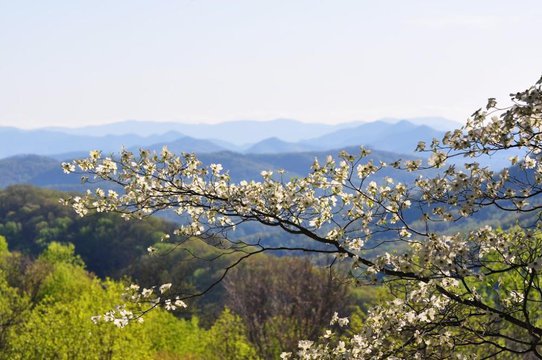Note: Foraging and photographing fungi and forest plants can be a fun and exciting hobby, however, we recommend only foraging for foods that you can clearly identify. McDowell Tourism strongly suggests taking advantage of field guides, mycologists (experts that study fungi) and TRUSTED expert online resources before using any fungi that you forage.
With recent rainfall and the changing seasons rolling into the Blue Ridge Mountains, McDowell County showcases a bio-diverse array of natural treasures to discover, photograph, or forage. Whether you’re a seasoned enthusiast or a curious beginner, our Blue Ridge Mountain community is surrounded by woodlands and old growth forests perfect for natural foods, flowers, and herbs. There is a long tradition of mushroom foraging in our region, stemming from early medicinal remedies from native indigenous communities and early pioneers, who sought remedies while living in remote regions of the state. These days, a new generation of outdoor explorers and outdoor recreationalists pursue foraging with a new sense of discovery; combining their love of natural food sources and science to the field of foraging.
McDowell County, NC is a great place to seek out new and exciting foodstuffs. Specifically, mushrooms and fungi are dominating Social Media as the next tasty find. Spring or Late Summer/Early Fall are the best times to search for mushrooms and fungi, as these seasons provide optimal conditions for mushroom and plant growth. Head to deciduous forests, riverbanks, and areas with high moisture levels. Fallen trees and decaying leaves serve as ideal substrates for spring mushrooms.
Notable Mushroom Species in McDowell

Chanterelles
These colorful mushrooms vary in light orange to vibrant reds and are highly sought after for their aromatics and flavor. Older forests: Chanterelles grow best in older forests. Areas with lots of coniferous trees: Chanterelles grow well in areas with lots of coniferous trees, especially after it rains. McDowell County, NC is home to at least four notable chanterelle types. Be sure to bring a proper identification guide with you on your adventures. Caution: Some toxic species of mushrooms can resemble early/young chanterelles. Note the differences (such as false gills and texture) or consult experienced foragers or mushroom experts if unsure.

Tree/Shelf Fungi, and Boletes
During the spring and summer months, keep an eye out for Lionsmane and shelf fungi on the “wet” side of trees in old growth forests. Lionsmane has few look-a-likes, so just be aware of it's soft cluster of downward pointing "teeth" growing out and downward from a singular patch. Boletes are distinguishable by their thicker stalks and size. However it may be tricky identifying the multiple types of edible bolete mushrooms while in the wild, but many boletes make great organic dyes for natural fibers. Just keep them separate from the rest of your finds.

Morel Mushrooms
Morels are prized mushrooms are sought after for their delicious flavor. Found in Western North Carolina from late April through early June, look near dead or dying elm trees. Morels often grow near the base of dead or dying trees, especially elm, ash, aspen, and oak trees. Morels tend to appear first on the side of a hill that gets more sun, especially south-facing slopes. Morels can be found in areas that have been recently disturbed, such as burned or logged woodlands, or after farmers burn ditches in the spring.

Oyster Mushrooms & Cluster Fungi
There are a variety of different Oyster and cluster fungi growing in and around the Pisgah National Forest. For this reason, we strongly recommend using guide books and taking a more knowledgeable friend on your foraging adventures. From delicious grey or pink Oysters, to toxic Jack-O-Lanterns (Omphalotus illudens or Omphalotus olivescens)
Foraging & Safety Precautions
Wear long sleeves and pants while foraging, and use a basket or bag designed for collecting mushrooms and plants. Many foragers use a mushroom knife or gardening knife as well as gloves. We strongly recommend carrying identification guides available online or at local bookstores. The most important foraging find tip is "When in doubt, throw it out (or don’t pick it up at all)". Many look-alike mushrooms can be dangerous, and plants can appear too similar depending on the season. If you stumble upon something you cannot easily recognize, avoid cutting or harvesting.
Other Considerations:
- Mind local regulations, rules, and posted signs.
- Avoid trespassing on private land.
- From the NC Forest Service Website: “A permit is required to collect any forest product in bulk or for commercial purposes. Some forest products may be collected in limited quantities for personal use without a permit, but a free or fee permit may be required so check with your local Ranger District.” Learn more on their website here: National Forests in North Carolina - Passes & Permits (usda.gov)
- Ginseng Foragers: Take notice, NC Forest Service has continued to suspend Ginseng permits through 2024. Learn more about ginseng harvests HERE.
- Commercial (Mid-Large Scale) collecting or disturbing mushrooms is prohibited on many national park service lands, including the Blue Ridge Parkway. However, in some parks, small amounts of edible mushrooms may be collected for personal use, limited to a maximum quantity per person per day. Note that many mushrooms are poisonous and should not be eaten unless you are able to correctly identify the species and know that it is edible. Collecting mushrooms for research or educational purposes may be allowed, but requires a permit. For more information, please visit park websites for regulations on mushroom collecting in specific parks.
McDowell County, NC and our neighbors have many great mushroom and foraging resources. Check out some of these Local Foraging Tours and Farms:
● No Taste Like Home Wild Food Tours: Explore McDowell County’s natural bounty with expert guides. Enjoy a cooking demo and tasting. Located in Asheville.
● Black Trumpet Farm: Selling to select wholesalers, farmeres markets, and also selling mushroom kits online. From Marion, NC located in Asheville.
● Savvy Shrooms: Foraging Tours and More. Based in Marion, NC
When foraging for mushrooms, it’s crucial to avoid certain poisonous species. Here are some mushrooms you should steer clear of:
- Death Cap (Amanita phalloides): Among the most toxic mushrooms globally, the death cap is responsible for many mushroom-related deaths. It grows in various countries.
- Conocybe filaris: Found in Europe, Asia, and North America, this mushroom contains the same toxins as the death cap.
- Autumn Skullcap (Galerina marginata): Another dangerous species to avoid.
- Destroying Angel (Amanita ocreata): This mushroom is also highly toxic.
- False Morels (Gyromitra esculenta and Gyromitra infula): These mushrooms should be avoided as well1.
On September 7th, 2024, the Marion Tailgate Market will be hosting their first ever Fungi Fest! A variety of fresh mushrooms will be for sale from local professional mushroom foragers and cultivators. Local chefs will be showcasing delicious dishes and cooking demos with mushrooms. Culinary mushroom grow kits will be available for folks to take home the FUN!

Remember to exercise caution and seek guidance from experienced foragers or mycologists when identifying wild mushrooms! 🍄🌿




